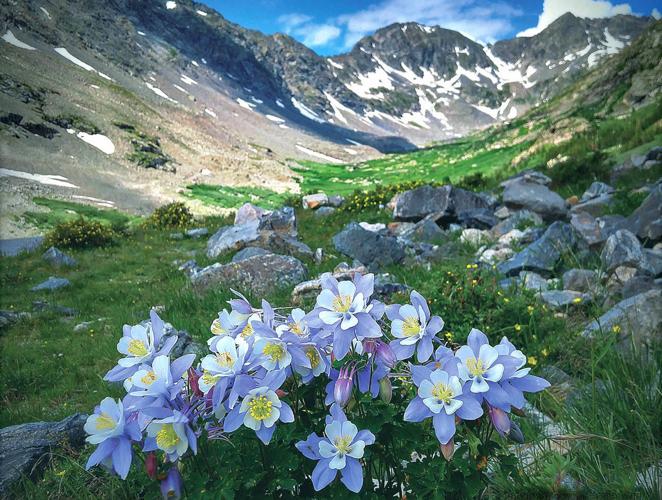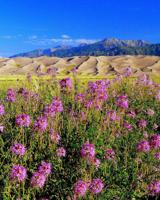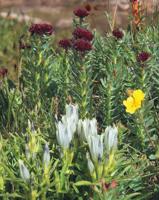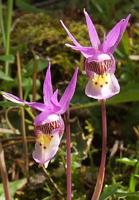It’s high season for some of the most breathtaking arrays of wildflowers the state offers—you’re going to be hiking, camping, heck, even walking in your neighborhood—why not check out these Instagram-worthy flashes of beauty for yourself? We asked wildflower experts Linda and Bernie Nagy, authors of Rocky Mountain Wildflowers Field Guide and South Park summer residents, for the scoop on where to go; which flowers to look for; and her husband Bernie how to take a pic that will garner tons of hearts.
Presented by:
Visit High Country Artworks here
1. Crested Butte/Gothic

Crested Butte is known for its stunning wildflower season. Aspen sunflowers in this shot frame a picturesque fence along CR 317 toward Gothic. Photo Courtesy: Bernie Nagy
Crested Butte is known worldwide for its impressive fields of wildflowers, like aspen sunflowers, lupine, mule’s ears, corn lilies, and green gentian, and the town also hosts a Wildflower Festival every year in July.Even if you can’t attend, the flowers are still there, so be sure to head up just the same.

Green gentians tower over some purple lupine in a meadow near Gothic. Photo Courtesy: Bernie Nagy
The green gentian remains one of Linda Nagy’s favorite wildflowers. A Colorado Native Plant Master and author of Rocky Mountain Wildflowers Field Guide, she and photographer husband Bernie have logged thousands of miles and hours searching and finding the most beautiful places to view wildflowers. Bernie is a fabulous photographer who’s got myriad tips on how to photograph them, “Usually, I’m down on the ground and trying to avoid the ants,” he laughs.
Photo tip: If your camera has portrait mode, use it unless you would like to get the background in focus too—see shot above with the mountain in the background for an example of results while keeping the portrait mode off so every element is in sharp focus.
2. Ashcroft, Aspen in Pitkin County

Close-up green gentian blossoms with bee. Photo Courtesy: Bernie Nagy
Here are our stately green gentians, in close-up with a fuzzy visitor: Hurry--these beauties are already in bloom as of this writing in late June. They can grow to seven feet tall and remain leafy for decades until blooming in profusion—no one knows why they bloom when they do, but when they do, Frasera speciosa, their scientific name, never fail to delight.

Aspen visitors are awed by meadows like this, blazing with aspen sunflowers, larkspur and wildflowers. Photo Courtesy: Bernie Nagy
3. South Park’s Mosquito Range
Old man of the mountain are hairy sunflowers that nearly always face east (at Buckskin Gulch near Alma). Photo Courtesy: Bernie Nagy
The Nagys' summer residence includes fields, alpine meadows and tundra where they source some of the rarest flowers in the book, or more common blooms in the Mosquito Range paintbrushes, harebells and chiming bells. Their book was recently updated because scientists have DNA-mapped several wildflower species and changed their families from their original family classification due to new results, Linda said.

Linda Nagy photographing bittercress and blue chiming bells at the Mount Sherman trailhead in South Park. Photo Courtesy: Bernie Nagy
4. San Luis Peak and San Luis Valley

Here is a close-up of Parry’s gentian, also known as the mountain gentian. It was named after 19th century botanist, Charles Parry.
If you’re off to the Great Sand Dunes National Park or points south, take a side trip up into the mountains here or stay in the valley for the sweetest scenery imaginable. Rocky Mountain beeplants bloom from late June to early July.
Rocky Mountain beeplant thrive along the road to Great Sand Dunes National Park. These showy plants can grow to 4 feet tall, and as the name i…
5. Rocky Mountain National Park
Red king's crown with yellow avens and white arctic gentian. Photo Courtesy: Bernie Nagy
Hikers among campsites in Rocky Mountain National Park or in the mountains elsewhere in the state, between 10,000 and 11,500 feet can, spot some classics, including the king’s crown, arctic gentian, and the alpine avens.
Photo tip: To open up hard shadows in the subject or when shooting on a cloudy day, pack a small piece of white cardboard or a small silver photo reflector to fill light into the shade.
The sickletop lousewort is also called ram’s horn, thanks to its curved petals. These are found along trails and in open forests from 8,000 to…
6. Summit County, Breckenridge area, Gore Range
The mariposa lily (mariposa means butterfly in Spanish) might look like a fancy florist’s flower but this native perennial shows up all on its…
The Nagys' book is color-coded to help you quickly use the colors of flower petals to look up the genus and species of the flowers you see—it’s in its third edition and so is one of the most up-to-date guides you can get; it’s also small enough to stow in your pocket or backpack.
Photo tip: Setting your aperture between F4.5 to F8 will let the subject stand out from the background. Hold your breath, Bernie says, it will avoid a shaky, out-of-focus result as you snap the photo.

Just below Loveland Pass there are meadows with mountain laurel peeking out. Parts of this plant are very toxic and can be deadly. Photo Courtesy: Bernie Nagy

The tall coneflower attracts pollinators and can be found near stream sides and in moist soils. Photo Courtesy: Bernie Nagy
7. Wildflowers in wooded areas and forests
The red columbine is found in moist soil near the edges of woodlands and within clearings. Photo Courtesy: Bernie Nagy
Certain flowers love the shady woods and can only be found with a careful eye and an even softer step. The red columbine usually is easy to spot, however, the wood nymph is tiny and not seen easily. The Nagys advise staying to the trails so you don’t inadvertently crush this delicate flower: It’s from the Heath family, and high on the list of Bernie’s favorites because it looks like a miniature Christmas star. If you’ve got a charged up Kindle, or a phone with the Kindle app on it, download the book instantly to identify these shy, mountain marvels.

Blink and you will miss the tiny wood nymph growing close to the ground in moist forest soil. Photo Courtesy: Bernie Nagy
The fairy slipper is a native orchid that grows in small patches or singly on short stems up to five inches high. Photo Courtesy: Bernie Nagy
8. Wildflowers along streamsides, creek beds, wetlands
Red paintbrushes may come in salmon or pink because they often hybridize with other paintbrushes. Photo Courtesy: Bernie Nagy
Moisture dictates the start and finish of “high” wildflower season, depending on how much snowmelt there is and when it begins. In the meantime, certain Rocky Mountain areas are moist all of the time and there you can source bittercress, chiming bells and other blooms who love the water.
Photo tip: Some of the best pictures include water in the background for an interesting visual element Here you may use a tripod or steady surface so that you can take a longer exposure with smaller aperture. This makes the water "look smooth as silk," said Bernie.
9. Wildflowers at high altitudes, alpine region
Rock jasmine and spring beauty at 14,000 feet after snow melt at Mount Evans. Photo Courtesy: Bernie Nagy
Alpine flowers do not appear at the same time as those growing lower than 11,500 feet. Many of the first springtime flowers like the avalanche lilies lift their delicate heads while snow is still on the ground in the high mountain meadows. Other hardy, early risers include the whiteish marsh marigold and glossy yellow snow buttercup.

The glacier or avalanche lily arrives when there’s still snow on the ground. Photo Courtesy: Bernie Nagy
Globeflowers with white-to-cream colored blossoms are in the buttercup family. They often appear in large patches in high altitude summer mead…
Photo tip: For this shot, bring down your aperture by a half to a full stop or go to a faster speed setting. This creates a more pleasant result that is slightly underexposed, keeping the white areas at the base of this flower from getting washed out---you want to retain the flower’s natural beauty.
10. Wildflowers along roadsides
Golden eye sunflowers are among the splashiest of flowers, blooming for many weeks and possessing leaves that feel like sandpaper. Other roads…
As you embark upon your adventures in Colorado, stun your carmates with your knowledge, even if the roadsides are flying by. If you see a perfect photo, be careful pulling over before you shoot your masterpiece.

The delightful blue flax possesses flowers that bloom for just one day but the plant has plenty of buds to keep them blooming throughout the season. Photo Courtesy: Bernie Nagy
Photo tip: Shoot wildflowers early mornings until 11 or after 3 p.m. to add nice shadows to the picture. You can also have your friend create shade to gain the same effect by standing behind the flowers.
11. Rocky Mountain Wildflowers Field Guide
The Nagys' book supports two long-time Coloradans’ small business and will help you enjoy your outdoor adventures this summer and fall to the utmost. Order online at www.highcountryartworks.com for a signed copy and mention code OTWILDFLOWER at check out for a price better than your usual online retailer –with free shipping. Use the link: https://highcountryartworks.com/discount/OTWILDFLOWERS
Or instantly download the award-winning eBook from Amazon before you get up to the rainbow of high country meadows where often there’s no cell service to be had.
The Nagys' last tip is the most important:

Drawing by Linda Nagy















































